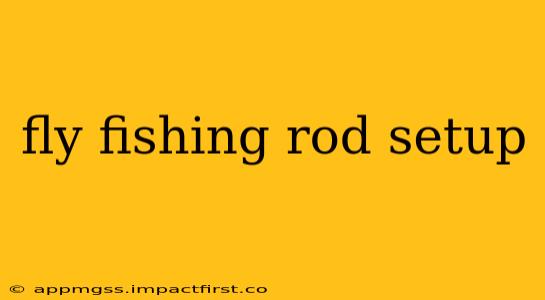Fly fishing, a sport steeped in tradition and technique, demands a precise and well-balanced rod setup. Getting it right is crucial for a successful day on the water, whether you're targeting trout in a crystal-clear stream or bonefish in a turquoise flat. This guide will break down the essential components of a fly fishing rod setup, helping you understand each element and how they work together.
What are the essential components of a fly fishing rod setup?
A complete fly fishing rod setup involves several key components working in harmony:
- The Rod: The foundation of your setup, the rod’s length, weight, and action dictate its capabilities and suitability for various fishing situations.
- The Reel: This houses your fly line and backing, providing the means to retrieve and control your line. The reel's size and type should match your rod.
- The Fly Line: This is the heart of the casting system, transferring energy from your rod to the fly. Different fly lines are designed for specific purposes and conditions.
- The Leader: A tapered length of monofilament connecting the fly line to the fly, acting as a delicate bridge between the two.
- The Tippet: A shorter length of even-diameter monofilament attached to the leader, supporting the fly.
- The Fly: The artificial lure designed to imitate insects or other aquatic creatures.
What type of fly line should I use?
Choosing the right fly line is crucial. Several factors influence this decision:
- Weight Forward: This is the most common type, concentrating weight in the front section for efficient casting. Ideal for most situations.
- Weight Forward Floating: The most versatile; floats on the surface, perfect for dry fly fishing.
- Weight Forward Sinking: Sinks at a specific rate, ideal for fishing subsurface patterns.
- Shooting Head: This line has a heavier head section followed by a thinner running line, allowing for longer casts. Best for distance casting.
- Floating Line: Sits on top of the water, used for dry flies or surface presentations.
- Sinking Line: Submerges below the surface, needed when fishing nymphs or streamers in deeper water.
How do I choose the right fly rod for my needs?
Selecting the appropriate fly rod depends on the type of fishing you intend to do and the environment you’ll be fishing in.
- Length: Longer rods (9-10ft) are better for distance casting, while shorter rods (7-8ft) offer more precision and are ideal for smaller streams and tight quarters.
- Weight: This refers to the rod's line weight capacity (e.g., 5-weight, 8-weight). It indicates the line weight the rod is designed to cast efficiently. Heavier weight rods cast heavier lines, suitable for larger fish and windy conditions. Lighter weight rods are ideal for smaller fish and calmer water.
- Action: This refers to how the rod bends when casting. Fast-action rods bend primarily in the tip, providing powerful casts, while slow-action rods bend along their entire length, offering more finesse and feel.
How important is the reel in a fly fishing rod setup?
The reel, while seemingly secondary, plays a critical role:
- Size: The reel should be appropriately sized for your rod and line weight. A larger reel can hold more backing, important when battling large fish.
- Drag System: A smooth, reliable drag system is essential to control the fish during a fight and avoid breaking your line.
- Construction: Durable materials are crucial to withstand the rigors of fishing.
What are the different types of fly leaders and tippets?
The leader and tippet are crucial for presenting the fly naturally:
- Leader Material: Typically made of fluorocarbon or monofilament, these materials offer varying degrees of visibility and strength. Fluorocarbon is less visible in the water.
- Leader Taper: The leader tapers from thick to thin, improving casting efficiency and making the presentation more delicate.
- Tippet Material: Typically thinner than the leader, matching the diameter of the leader tip for seamless transition. Choose the right diameter for your target fish.
What factors should I consider when choosing a fly?
Fly selection is crucial to success and hinges on:
- Imitation: Choosing a fly that closely resembles the insects or baitfish present in the water is key to attracting fish.
- Water Conditions: The fly's color, size, and pattern should match the water clarity and visibility.
- Fishing Method: Different flies are designed for different techniques, such as dry-fly fishing, nymphing, or streamer fishing.
By carefully considering each component of your fly fishing rod setup, you can ensure a more efficient, enjoyable, and successful fishing experience. Remember that practice is key to mastering the techniques and developing your intuition for the nuances of fly fishing.
